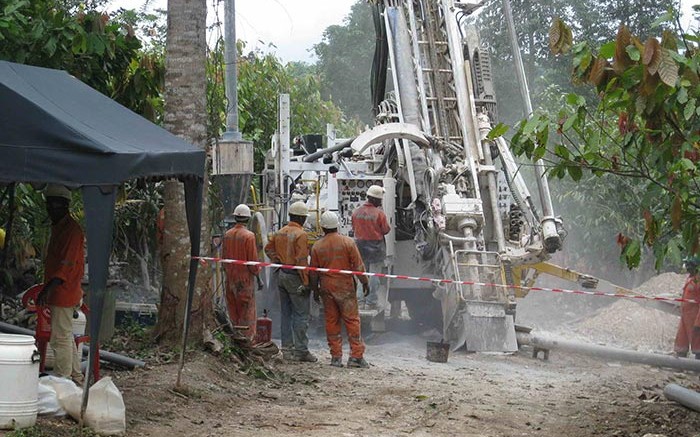VANCOUVER — It’s early days for junior Pinecrest Resources (TSXV: PCR) at its Enchi gold asset in southwestern Ghana, West Africa, but the company is off to a promising start. Pinecrest has just released a preliminary economic assessment (PEA) on the project that models a low-cost, heap-leach gold operation with attractive economic returns.
Enchi has suffered from disjointed ownership over the past five years, as it passed through the hands of a few companies before splitting fifty-fifty between producer Kinross Gold (TSX: K; NYSE: KGC) and junior Edgewater Exploration (TSXV: EDW). The property was originally part of Lukas Lundin’s Red Back Mining before Kinross took Red Back out in mid-2010 for US$7.1 billion.
Pinecrest picked up Enchi in late 2014 and fully consolidated ownership of the project, which opened the door to financing and strategic partners. The company fast-tracked its PEA on the back of work completed by previous operators, including 50,000 metres of drilling.
Enchi covers 50 km of strike on the prolific Bibiani shear zone, which sits east on the Sefwi belt from southwest Côte d’Ivoire to the Suhuma Forest Reserve northeast. Red Back and previous explorers identified 16 mineralized zones at the site that have the characteristics of classic Precambrian, greenstone-hosted, quartz vein-style gold deposits.
“Prior to the consolidation I’d say Enchi was definitely impacted by the ownership situation, where no one was advancing the project as a primary asset,” president Ryan King says during a phone interview.
“Not to mention previous operators were really impacted by a pullback in available exploration dollars. It’s essentially a brand-new story, but we have some really strong shareholders who, I believe, see the promise here. What we’re really striving to do is crystallize the project’s value and demonstrate it has a real future as a mine.”
The consolidation also led to an alliance with streaming and royalty outfit Sandstorm Gold (TSX: SSL; NYSE-MKT: SAND) and a $3.6-million private placement, wherein Pinecrest issued 18 million units at a price of 20¢ per unit. Each unit consists of a share and a purchase warrant exercisable for two years. Sandstorm picked up 10 million units, and now holds an 18.2% equity stake in Pinecrest. Kinross has a 19.9% interest in the company through its Red Back vehicle.
With the cash influx, Pinecrest polished off its inaugural economic study at Enchi, which boasts total inferred resources of 37.4 million tonnes grading 0.9 gram gold per tonne for 1.1 million contained oz. The company’s PEA accounts for 540,000 oz. across three zones: Sewum, Boin and Nyamebekyere.
Pinecrest modelled an operation with a central heap-leach pad that would service all three deposits, with ore hauled from 3 to 6 km from different open pits. Enchi would produce an average 74,850 oz. gold annually at a 1.24-gram head grade in its first two years. Over a total 8.7 years, the mine would produce 61,750 oz. gold annually at cash costs of US$802 per ounce.
Enchi’s development would set Pinecrest back US$84 million, and feature a US$62-million after-tax net present value at a 5% discount rate, and a 24% internal rate of return. Financial models used a US$1300 per oz. base-case gold price.
Ghana’s 2,125-megawatt electrical generation capacity comprises 50% hydro and 50% thermal plants. There is a 33-kilovolt line available near the property with a few options for connection routes, depending on demand and capacity required.
“What we’ve designed is a relatively low-capital, heap-leach project that’s owner operated. I think these types of opportunities have been well received by the market, plus West Africa is a great place to build a mine, and I think it’s only going to get better over time,” King says.
“We have a lot of opportunity for growth,” he adds “For example, Kinross’ Chirano mine 50 km north started off with near-surface mineralization at a similar grade to what we have at Enchi. They really found the ‘jewellery box’ a bit deeper, in the form of some great sulphide zones.”
Pinecrest had US$2.5 million in its treasury at press time, but the company is conservative about Enchi, despite its promising start. King says follow-up plans include a 1,000-metre metallurgical drill program, though the company will dig into exploration work on the project’s 696 sq. km greenfield expanse.
“It’s just a small program to start, because we realize that money can be hard to come by in this market, and we want to be positioned to really benefit when things bounce back,” King says. “That means allocating money efficiently, while also assuring we continue to develop the asset. Could there be a follow-up financing in the next three to six months? I’d say definitely. We’d like to get started on the regional exploration.”
Pinecrest’s shares have risen 181%, or 29¢ over the first two months of the year, and closed near a 52-week high of 45¢ after news of Enchi’s PEA. The company has 38 million shares outstanding for a $17-million market capitalization.


Be the first to comment on "Pinecrest builds momentum at Enchi with maiden PEA"